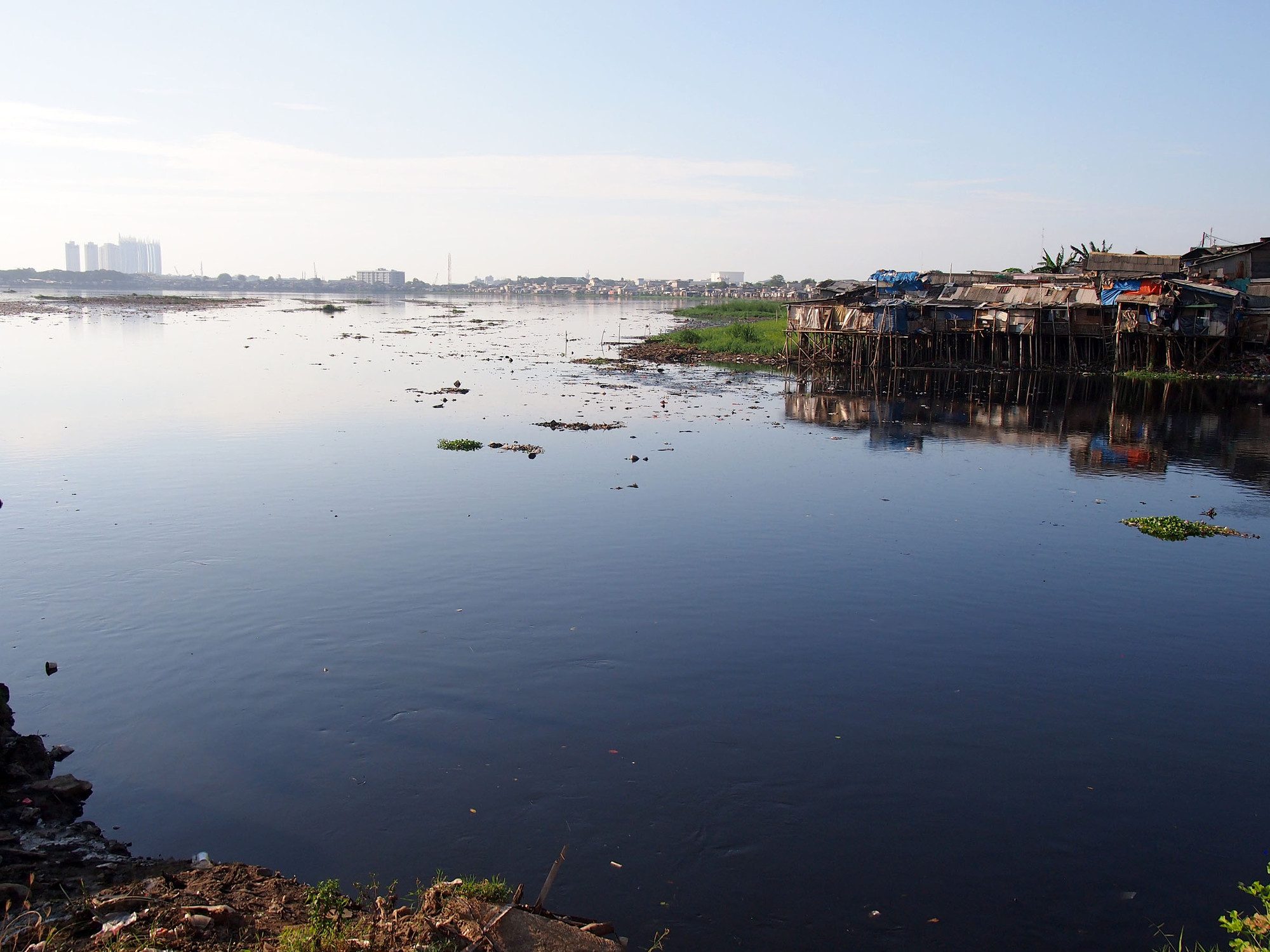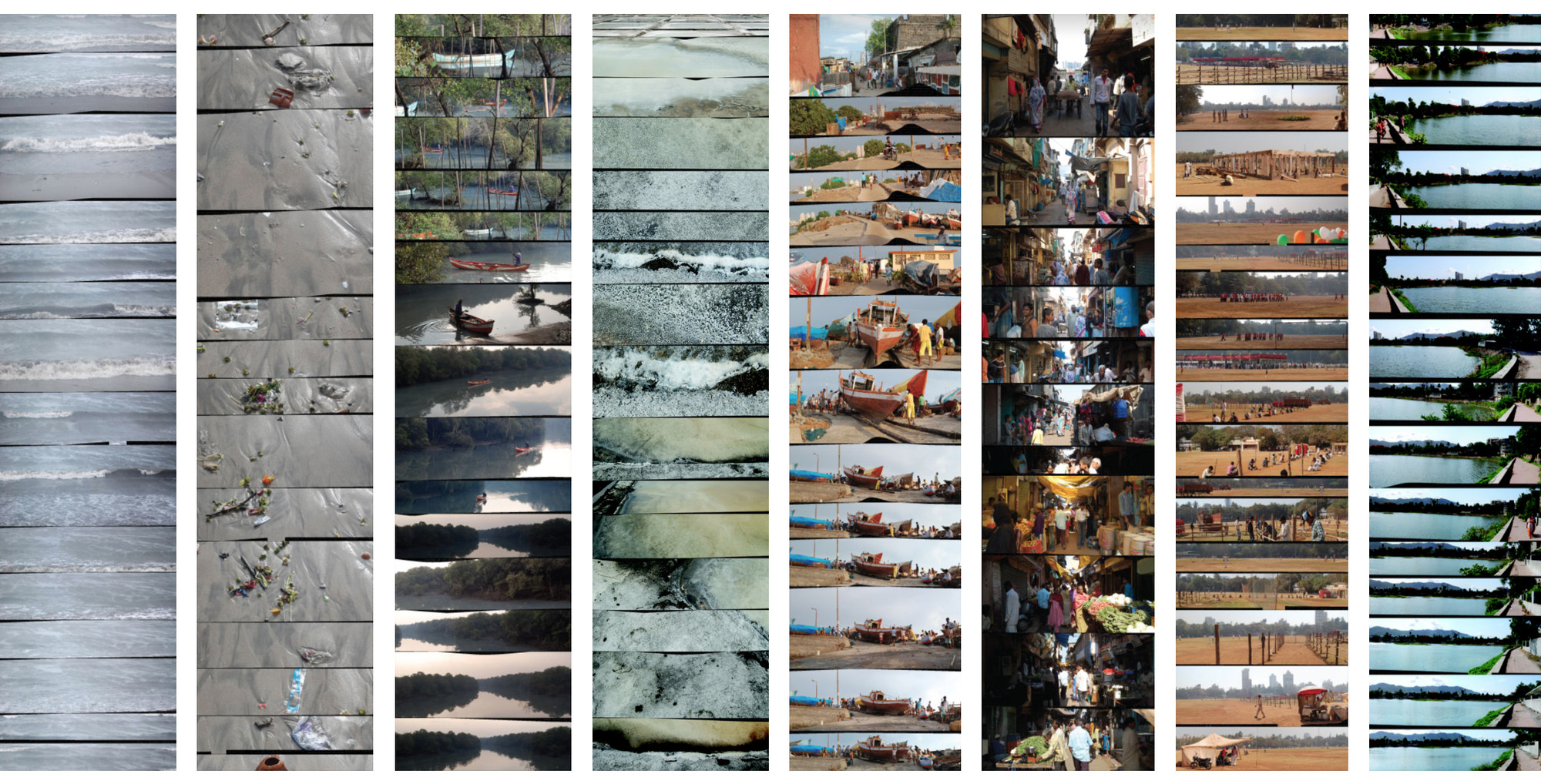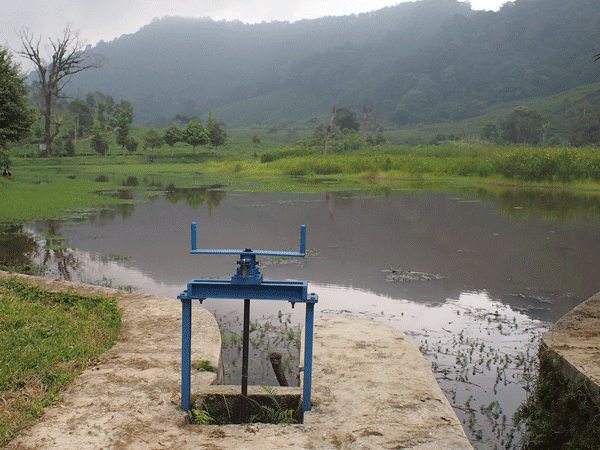Architecture and Global Ethnographies
Kian Goh

Pluit Reservoir in North Jakarta, July 2013. Photo: Kian Goh.
Architects are turning towards justice. We can see this in the rise of socially-oriented student groups in architecture schools, new organizations focused on labor rights and fair representation among architects, and design projects that take on justice-related concerns such as workers centers and housing for refugees. Some have also critiqued practices that are deemed oppressive and unjust, such as designing detention centers, and even, more generally, the hegemonic nature of prevailing systems of management and production in which our practices are embedded.
These efforts, at heart, involve interrogating the relationships between the making of the built environment and the politics of belonging in places. Such a turn towards a reflexive contemplation of architectural practice is perhaps unsurprising, given social and political conditions today. Architects, while historically not always sensitive to social issues, have always considered design as a broad-view endeavor. Now faced with nativist, reactionary, and exclusionary politics, we look to design concepts that emphasize inclusion, equity, and local, community-oriented solutions.
But what does such a turn mean when we are also facing the existential crisis of climate change? The threats of climate change, which effect multiple scales of geography and levels of social and governmental action, will require global collective action to address and, hopefully, halt or reverse.1 On the one hand, we should be more and more attune to the local and immediate. But on the other, we need to critically engage the global and long-range. The puzzle is, how can architecture take seriously various social marginalizations and, at the same time, offer a responsibly global, transformative vision? Architecture’s past is strewn with the debris of failed big ideas and plans. How do we think big while avoiding the injustices of past visionary practices?

Ciliwung River at Bukit Duri and Kampung Pulo, Jakarta, July 2013. Photo: Kian Goh.
Insurgent citizenship
Anthropologist James Holston, critiquing a previous era of big thinking in architecture and planning, asserted: “modernist planning does not admit or develop productively the paradoxes of its imagined future… it attempts to be a plan without contradiction, without conflict.”2 At the heart of Holston’s critique is modernism’s presumed neglect of the actually-existing social when conceptualizing idealized worlds, and its decontextualized approach to imagination that ignores, in most basic terms, how to get from “here” to “there.”
In contrast, Holston pointed to what he termed “insurgent citizenship,” alternative social practices to dominant forms of space in the modernist city. He positions these practices in opposition to the accepted notion of the state as the legitimate source of citizenship. Holston’s thinking primarily reflects the kinds of urban projects and politics he sees in Latin America, in particular Brasília (although the planning ideas he cites are more general). There, the divide between state-sanctioned citizenship—and its imagined social and aesthetic order—and alternative visions and practices are particularly clear.
It’s worth emphasizing the assertion here: Holston places the state alongside modernity and utopianism. Spaces of modernity are state spaces. Top-down ideas of citizenship, therefore, follow processes of decontextualization and a neglect of the social. For designers and planners, Holston called for a different social imagination, which he explicitly termed “ethnographic” versus “utopian”: an “ethnography of the present.”
Critiques like Holston’s join others who similarly take issue with rationalized, universalist modernist principles, and those who elevated the lives and actions of people who find themselves in various ways outside the state, such as Janice Perlman’s depictions of favela residents in Rio de Janeiro.3 They pave the way for theoretical and practical approaches that prioritize ground-up movements, and pay attention to the agency of marginalized populations. They highlight the inclusionary practices and alternative spatial imaginaries crafted by residents of informal settlements, for example, and elevate the work of organized slum and shack dwellers.4
This tide of thinking was taken up by designers in a prior wave of ground-up-oriented, socially-aware design. Teddy Cruz talks about “creative acts of citizenship,” by which he means how people on the margins—immigrants and border crossers, epitomized by those around his home base of San Diego-Tijuana—practice forms of social and spatial organization and invention, creating places of belonging, pixelating the standardized spaces of state and capital. Cruz’s creative citizens bring Holston’s insurgencies into a more deliberate space of design. In common, they maintain that questions of citizenship are questions about how people belong to societies.
These kinds of practices and spaces, modeling new possibilities of citizenship, take on greater significance as we witness, from Standing Rock and Ferguson to, now, Muslim bans and family separation at the borders, egregious actions of the state to revoke belonging and legitimacy.

New concrete embankments at the Ciliwung River, Bukit Duri and Kampung Pulo, May 2017. Photo: Kian Goh.
Climate insurgencies?
At the same time, in a time of climate change, Holston’s concept of insurgent citizenship and the kinds of designed interventions they might inspire require revision and extension. The scales and levels of climate change threats extend beyond the realm of community social interactions or place-based cultural practices that anchor such insurgent citizenship. Think, for example, about storm surge or sea level rise protections in a coastal urban region, or water management across a watershed. Questions of agency, central to these alternative notions of belonging, need to be recast across larger and more complex territorial boundaries, and diffuse, uncertain risks.
Holston’s conception of the state, too, and its oppositional relationship to insurgent practices, needs reconsideration. We have seen both the necessity and limits of the state in climate change actions. Countries take part in formal, multilateral negotiations at the United Nations Framework Convention on Climate Change (UNFCCC) conferences, discussing agreements, setting targets, and arguing responsibilities and vulnerabilities. But their lengthening history of insufficient action has brought attention to the possibility of other avenues. Scholars of global environmental management have pointed that there is increasing fragmentation and complexity in the array of institutions, actors, and scales involved in thinking and acting on climate change, including subnational governments, NGOs, and firms and individuals, in a system of transnational, multilevel governance. They have noted the rise of cities as sites of action as well, both in progressive and status quo ways.5
These complex, multiscalar, multilevel conditions and avenues of action demand a correspondingly reflexive response from architects working at the intersection of social and environmental concerns. Going back to Holston, for whom citizenship is not a stable status but a terrain of claims and struggles, could we imagine an architectural response that is simultaneously ethnographic and utopian? In other words, what might an ethnography of the present look like, confronted, on the one hand, by very local and immediate tears in the fabric of social life, and, on the other, globalized, existential climate crisis?
In Jakarta, Indonesia, for example, a city confronting some of the worst social and environmental challenges, poor urban residents living in informal “kampung” settlements along rivers and coastline have been fighting to remain in their homes. They face displacement pressures from two sides: environmental catastrophe, in particular severe flooding exacerbated by rapid land subsidence and increasingly uncertain weather conditions; and urban development, including efforts by the city government to reclaim the land for recreational uses and large-scale infrastructure projects.
In response, community organizers and kampung leaders formed coalitions with architects, planners, and researchers to develop their own plans for rehousing in place. For example, in Bukit Duri and Kampung Pulo, two kampungs straddling a bend in the Ciliwung River, Ciliwung Merdeka (literally “Free Ciliwung,” a community organizing group) worked with Kota Kita (a citizen planning organization), urban planning and landscape architecture interns from Harvard University, and an architecture intern from the Asian Coalition for Housing Rights, a housing advocacy organization. They facilitated community mapping, and proposed a new “stacked” housing model, designed to open up the river edge and enable river widening and maintenance access while maintaining the physical and social fabric of the settlement.6 These “counterplans,” posed against the dominant city or state-led modernization plans, offer a striking example of Holston’s insurgent citizenship. They harness the tools and strategies of design in order to assert claims on space and alternate notions of belonging.
And yet, they may not be enough. While kampung organizers have succeeded in garnering negotiations with city leaders, the community-led plans have not been implemented, and eviction and displacement has largely continued. Furthermore, although these plans center around community history and social ties, they do not engage some of the larger environmental conditions the city faces, including issues of land and water management across the watershed, and rampant patterns of urban development that decrease infiltration and exacerbate flooding. How can we extend this kind of community-based spatial design and planning to larger scales, those capable of acting with territorial agency?

Ciliwung River flood monitoring display at Katulampa water gate, May 2017. Photo: Kian Goh.
Methodological interventions
The answer to this question lies both within architecture itself and far outside it. Architects have embraced research as a relevant part of design activities, but have rarely embarked on sustained deliberations on method. The ways in which architects have long been trained to understand and act in design practice offer lessons for reflexive methods that have increasingly become part of interdisciplinary social science and humanities scholarship. These methods, along with the discipline’s intrinsic mode of operation—to think projectively through spatial concepts—can broach new kinds of practices to take on our multiscalar, multilevel challenges. A deeper understanding of these possibilities would make more clear architecture’s role to play in ongoing struggles over local and global futures.
Jakarta’s flooding problems involve historical social and spatial marginalizations and multiscalar ecological pressures, often at the scale of the watershed and beyond. In these situations, different worldviews of the relationship between urban space and nature define our understanding of social and environmental problems, and inform our possibilities for action. If one holds a more positivist, biophysical viewpoint, one might find that land subsidence and inadequate infrastructure are the primary causes of flooding. Alternately, if one holds a more constructivist, sociopolitical viewpoint, one might find that social inequality and unjust government policies against the urban poor are to blame.7
We need new methods of analysis to think through these conflicting viewpoints and pose solutions for new sites and scales of urban problems. One way is to look to emerging ideas around the ethnographies of places and environments (in addition to sociocultural practices) proposed by researchers such as anthropologist and environmental studies scholar Anne Rademacher.8 In this approach, changes in biophysical environmental conditions, such as states of water, are as critical as those of social practices. Ethnographies of environments and practices expose the ways in which changing biophysical conditions are intertwined with changing historical-social outcomes.

Composite drawing of Mumbai’s landscape by Anuradha Mathur and Dilip da Cunha, from Soak: Mumbai in an Estuary, 2009
Another lies in the work of landscape architects such as Anuradha Mathur and Dilip da Cunha.9 They show how a literal shift in viewpoint—looking at ecologies in the city in section rather than plan view—enables interfaces of land and water in an estuary to be understood differently, not as simply wet or dry, but as a gradient, with depth. This viewpoint shift encourages a different understanding of wetness and terrain and, correspondingly, an expansion of the realm of solutions to urban environmental problems, such as flooding in cities.
Melding these two types of approaches offers an alternative design methodology that traces sectional relationships across both multiscalar, spatial, and biophysical aspects of place, and sociopolitical levels of power, ones that are site-delimited as well as those that transcend specific sites. Such an extended view illuminates the ways in which problems of socio-ecological marginalization in very local places can be traced to power relations that are often globally and historically constituted, across space and time.
For Jakarta, this methodology shows how poor urban residents’ struggles to remain in place in informal kampung settlements are not only in response to local conditions such as severe land subsidence and increasing flooding, but also linked to histories of unequal social and spatial development in the city, both during and after the colonial period. It further shows how they are linked to circumstances far beyond the site and city proper, including the shifting trajectories of globalized urban development and global environmental governance. In particular, it reveals the ways in which new networks of national agencies, cities, and transnational infrastructure companies are proposing ambitious urban development projects, ostensibly in response to environmental threats but often at the expense of poor urban residents.
In addition to clarifying the kinds of urban social and environmental problems we see in places like Jakarta, this way of seeing also expands our view of possible actions. It shows the potential of interlinked political organization and design conceptualization beyond the scale of the local site and direct community concerns. It illustrates, for example, how fights over urban development and landscape uses in the upper reaches of a watershed—managing water flow and infiltration—can aid anti-displacement struggles far further downstream. Or how networked strategies organized in response to more structural conditions such as shifting flows of global capital in climate change-induced urban resilience developments can be a part of very place-based social movements. We can see incipient examples of this in Jakarta, where community organizations are initiating collaborations across localities in the urban region and watershed, creating networked pro-poor advocacy groups across multiple cities, and developing sustained relationships with designers and researchers.

Headwaters of the Ciliwung River near Puncak, West Java, May 2017. Photo: Kian Goh.
Global ethnographies
Architecture has long been ineffective on issues of power, even as it nods to moments of injustice. As it grapples with a heightened social consciousness, such complacency must change. Our continual complicity with political authority and global capital must be challenged. A shift in seeing and thinking, looking simultaneously at people and places, traced across spatial scales and sociopolitical levels, would allow a more interrogative engagement with the complex articulations of power that define our practice, even as we take on burgeoning ecological crises.
We must think, therefore, not about global practices (as we are wont to do), but about global ethnographies. An ethnographic focus in architectural design processes—transforming not only how we envision solutions, but how we understand problems—can be part of the development of new models of socio-ecological citizenship. This is not a call for architects to play anthropologists, but to learn from the modes of knowledge that revolve around careful presence and sustained observation. Doing so would encourage us to look hard at historically-constituted social relationships in the manifold spaces we investigate and manipulate, to assess better the ways in which to get “there” from “here.”
To do this well, in ways that do not replicate the systemic injustices of past modernisms, requires both humility and ambition. To be attuned to local, site-, and historically-specific marginalizations, we must think of political design, not only in the abstract, but also in conjunction with social movements and material struggles. We must learn to learn from social movements, to understand power relations and alternative theories of change, and to create frameworks through which design theories and practices can align themselves with and become accomplices of such movements. To engage with the increasingly complex and interlinked spaces of global political-economic and environmental change, we must think collaboratively and extendedly, to follow the flows of capital, but to the end of upending conventional acquiescence. We must develop enduring relationships in key sites of practice, and collaborations with locally based organizations—asking, “who knows?” as an actual question and invitation.
-
IPCC, Climate Change 2014: Synthesis Report. Contribution of Working Groups I, II and III to the Fifth Assessment Report of the Intergovernmental Panel on Climate Change, R.K. Pachauri and L.A. Meyer eds. (IPCC, 2014), 151, http://www.ipcc.ch/report/ar5/syr/ ↩
-
James Holston, “Spaces of Insurgent Citizenship,” Cities and Citizenship, James Holston ed. (Duke University Press, 1999): 155–74. ↩
-
Janice E. Perlman, The Myth of Marginality: Urban Poverty and Politics in Rio de Janeiro (University of California Press, 1976). ↩
-
See, for example, the work of Slum Dwellers International, http://sdinet.org/. ↩
-
See, for example, Harriet Bulkeley et al., Transnational Climate Change Governance (Cambridge University Press, 2014); and, Mike Hodson and Simon Marvin, World Cities and Climate Change: Producing Urban Ecological Security (Open University Press, 2010). ↩
-
Kian Goh, “Terrains of Contestation: The Politics of Designing Urban Adaptation,” Perspecta 50: Urban Divides The Yale Architectural Journal, Meghan McAllister and Mahdi Sabbagh eds., (MIT Press, 2017). ↩
-
Kian Goh, “Urban Waterscapes: The Hydro-Politics of Flooding in a Sinking City,” International Journal of Urban and Regional Research (forthcoming). ↩
-
Anne Rademacher, Reigning the River: Urban Ecologies and Political Transformation in Kathmandu (Duke University Press, 2011). ↩
-
Anuradha Mathur and Dilip da Cunha, Soak: Mumbai in an Estuary (Rupa & Co, 2009). ↩